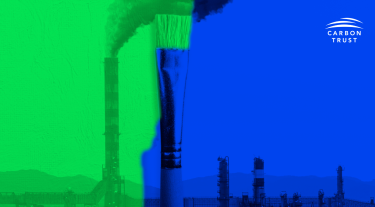What is greenwashing and why is it happening?
Greenwashing is the practice by which companies claim they are doing more for the environment than they actually are.
Greenwashing has increased as:
- Companies’ climate commitments are on the rise.
- Consumers increasingly seek to buy more sustainable products.
- Companies are incentivised to make products more attractive to consumers.
- Employees are attracted to work for companies with strong sustainability credentials.
What is the current communications landscape?
According to a report by the European Advertising Standards Alliance (EASA), complaints against environmental claims made up 15% of total complaints received for misleading adverts, with online advertising accounting for the highest share of complaints in Europe. The Competitor & Markets Authority (CMA) also found in a global sweep that 40% of green claims made online are using tactics that could be considered misleading and potentially breaking consumer law.
Greenwashing tactics for misleading environmental claims include:
- Vague claims and unclear language
- Statements that give the impression that a product had no negative impact on the environment
- Lack of easily-accessible, adequate explanation or evidence of the claims
- Eco logos and labels that are not associated with third-party assurance to international standards
- Hiding or omitting certain information to appear more eco-friendly
Why is greenwashing an issue?
Most importantly, making false environmental claims hampers decarbonisation progress and impact. If greenwashing is not addressed, it will undermine the efforts of genuine leaders, creating confusion, cynicism, and a failure to deliver urgent climate action. It is a collective problem which requires collective action.
Greenwashing also creates the following issues:
- Hamper investment strategies that support a Net Zero transition and can result in the misallocation of capital. Even worse, misleading statements could fund and perpetuate poor environmental practices.
- Being seen to mislead or lack transparency in communications can detrimentally affect brand trust and credibility, leading to commercial implications from both consumers and shareholders.
- Creates compliance risks. Regulatory frameworks are evolving fast heightening the risk that companies face who fail to comply when it comes to green and environmental claims.
- Companies that make false or exaggerated environmental claims may face increased costs for advertising and marketing to restore their reputation.
Greenhushing, the counterpart to greenwashing whereby companies deliberately choose to under-report or hide their environmental claims to evade scrutiny, is also on the rise – a trend that will lessen transparency and hinder climate ambition. If companies stop talking about what they are doing, it disincentivises others to commit to the bold action the world needs.
Top tips to counter greenwashing through transparent communications
Greenwashing has emerged as a significant worry for businesses, with two-thirds of executives reporting that greenwashing is a serious concern in their industries1. We know businesses want to be honest with their customers about their green credentials, but it may not always be clear how to do this.
How to transparently share your green credentials:
Be F.A.C.T.U.A.L:
F – Fact driven - be factual, specific and evidence based, including data sources
A – Avoid - claims of being first and saving the planet. Remember every product has an environmental impact – never suggest that a product actually benefits the planet. Humble communications vs over claims will create greater trust in your brand.
C – Check and verify your work.
- Check the CMA’s Green Claims Code principles for best practice for your environmental claims
- Reach out to your local self-regulatory organisation to seek copy advice. EASA acts as their umbrella organisation in Europe and the International Council for Ad Self-Regulation (ICAS) for other geographies
- Seek third party assurance to international standards to provide authority and rigour to claims so you can communicate with confidence
T – Truthful - be truthful on your progress of what you have and haven’t achieved and what you are still working on. Avoid positioning your environmental work as a completed task, but rather as a milestone along a long journey. Creating an on-going dialogue with your consumers, suppliers and shareholders to share where you are in your journey will help build credibility.
U – User friendly - if there's a claim that the product helps avoid emissions use simple, easy to understand language, free of acronyms. Include definitions of terms and how they have been applied to help explain. Also ensure easy access to further information and details.
A – Accountable - if errors in communication should arise, take responsibility for the error, apologise and explain how it will be corrected. Consumers and shareholders are more likely to forgive if you are open and honest with them.
L – Learn - no company’s journey to Net Zero will be the same based on sector, market, size, etc. To attain Net Zero requires a collective effort by all, so continuously learning, and sharing those learnings will help industries to accelerate to a decarbonised future.
How can third party assurance support your environmental claims?
Third-party assurance to international standards adds authority and accuracy to corporate environmental claims. The CMA states “symbols, trust or quality marks awarded by independent third parties on the basis of a formal assessment against lawful and objective criteria are less likely to be misleading”.
We believe companies should be auditing their environmental claims in the same rigour to their financial reporting. An important first step is to get your numbers checked and verified by an external expert.
Following verification, the next step is to certify your claims against an internationally-recognised standard with a trusted third-party organisation to help you communicate your achievements with confidence.
How can the Carbon Trust support?
The Carbon Trust provides independent verification and assurance services. With over 20 years of carbon expertise, we help companies move beyond a simple verification or methodology approval and seek to evaluate the credibility of the data and how it should be interpreted to inform future decision making.
Our expert sustainability communications team can advise you on the strongest message and approach to external communication, such as through our leading product carbon footprint label or Route to Net Zero Standard.
Your key questions answered
How do I avoid greenwashing across international boundaries when a product is being produced and sold in multiple countries?
The principles of transparent communication apply whether you are working on a global or local brand. Be factual, evidence-based and make sure your claims are not bigger than your achievements actually are. If you are being honest, truthful and accurate, you are going to be staying on the right side of the law.
It is the brand owners' responsibility to be aware of any additional local regulations or legislation with regards with green claims advertising. Should any claims needs to be adapted and local variations provided, they should be done so in line with local legislation. You can contact your local self-regulatory organisation (SRO) to get advice.
How do I communicate environmental claims that are used interchangeably, such as Net Zero and Carbon Neutrality?
It is the responsibility of a brands communication team to make sure the claims are accurate. If the definition of an environmental claim is not understood by the marketeer, it is probably not going to be understood by the consumer. If you have any concerns that a green claim may be misunderstood externally, err on the side of caution, and provide further substantiation with clear information around what you mean by a claim that has ill-defined terminology included.
As a marketer, you should seek to increase your understanding of these claims. You can do this by:
- Finding available resources – such as our Briefing: Net Zero for corporates
- Contacting your local SRO - they provide training programmes to help shed light on different sustainability concepts and provide copy advice to assess compliance of your content against national self-regulatory codes and appliable regulation
Do I need to provide further clarification of environmental claims and where should I communicate them?
Our guidance is if you can clarify it - do. Where you can, where you have time and where you have space, it is always better to provide more information than less. Where you cannot, such as space limitation on a products packaging, make sure you direct the consumer to where you are providing that information, such as your website or sustainability report. The information needs to be as easily accessible as it can be and we’d recommend using URL weblinks or QR codes, taking you directly to the source of information, and not just the products homepage.
Webinar: Countering greenwashing through transparent communications
Recorded February 2023
1. Deloitte, 2022



